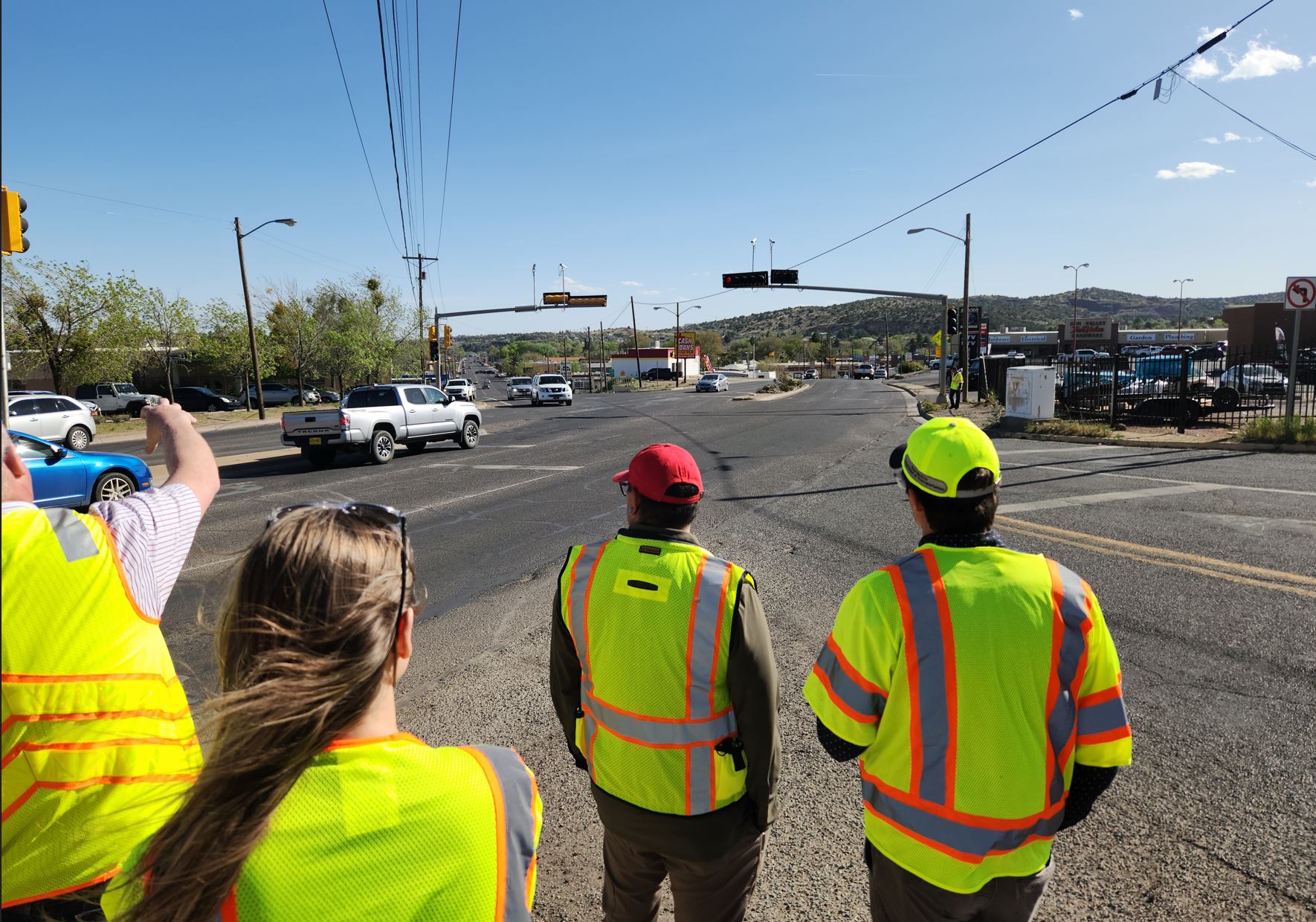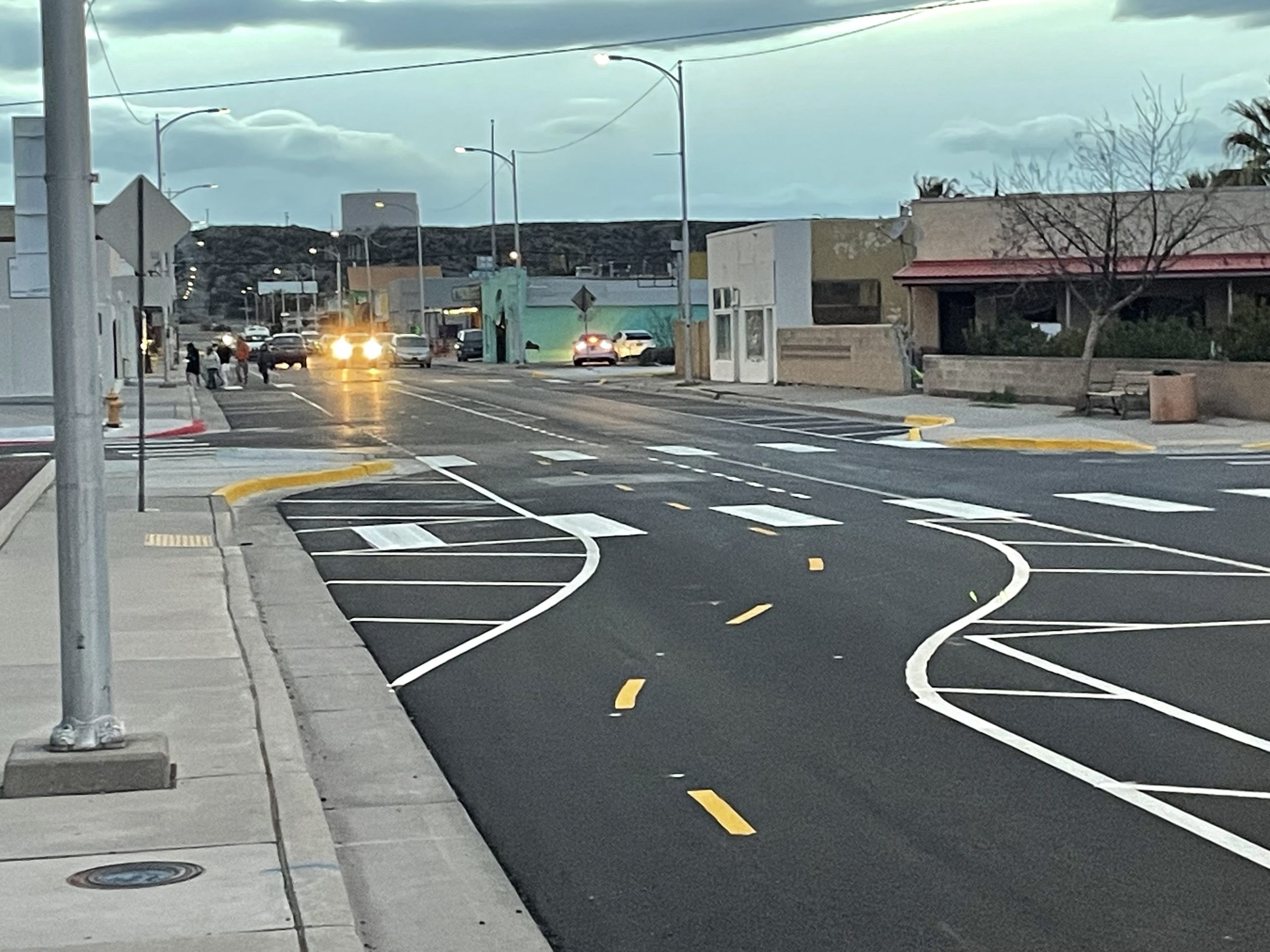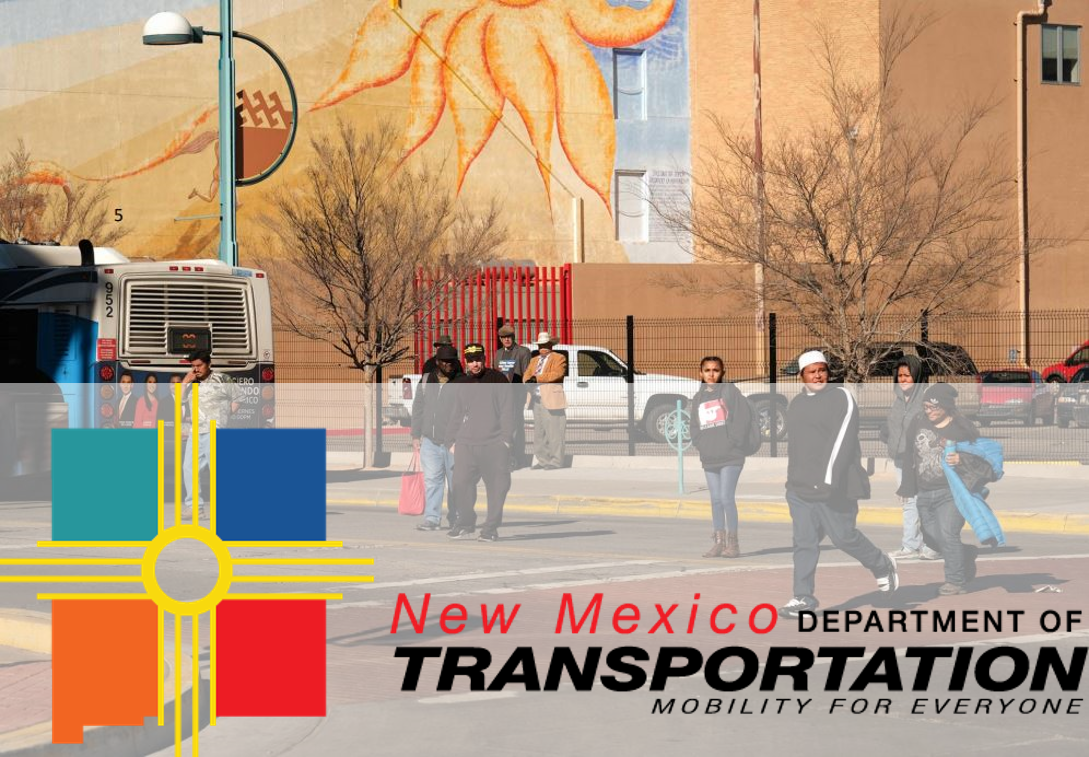Multimodal Planning and Programs Bureau
The Multimodal Planning and Programs Bureau (MPPB) develops a variety of transportation plans for the state or for smaller areas. Example include: the State Freight Plan, the Strategic Highway Safety Plan (SHSP), the New Mexico Bike Plan, the Pedestrian Safety Action Plan, the NMDOT Complete Streets Strategic Plan and other plans, including some community-level safety plans.
Additionally, MPPB works closely with the Metropolitan Planning Organizations (MPOs) and, for the non-metropolitan consultation process, the Regional Transportation Planning Organizations (RTPOs). MPPB oversees the Bicycle/Pedestrian/Equestrian (BPE) Program, Transportation Alternatives Program (TAP), Recreational Trails Program (RTP), National Freight Program (NHFP), and Highway Safety Improvement Program (HSIP). MPPB also develops and maintains the New Mexico Statewide Travel Demand Model and the Functional classification system. A number of the Bureau’s activities and projects are included in the Planning Division’s Planning Work Program.
Rosa Kozub, AICP, Multimodal Planning and Programs Bureau Chief
505-231-9869
rosa.kozub@dot.nm.gov

Related Links
Government to Government
Metropolitan Planning Organization (MPO) and Regional Transportation Planning Organization (RTPO).

The Multimodal Planning and Programs Bureau’s Programs Unit includes the Government to Government and Active Transportation Programs Teams.
Through these teams, the Unit manages the Transportation Alternatives, Recreational Trails, Bicycle/Pedestrian and Equestrian, Safe Routes to School, and Scenic Byways programs.
The Programs Unit and the Government to Government Team administers contracts for seven RTPOs and five MPOs, and work closely with NMDOT’s District Offices, STIP Bureau, Design Regions and other Divisions as a planning resource and to ensure compliance with state and federal planning requirements.
Contacts:
Alison Gillette, Gov’t to Gov’t Supervisor, MPO/RTPO Liaison
(Farmington MPO, Santa Fe MPO, Northeast RTPO, and Northern Pueblos RTPO)
505-469-8251
alison.gillette@dot.nm.gov
Vacant
(Mid-Region MPO, Mid Region RTPO, and Northwest RTPO)
Valerie Sherman, Urban & Regional Planner, MPO/RTPO Liaison
(Mesilla Valley MPO, El Paso MPO, Southwest, South Central, and Southeast RTPOs)
505-670-8259
valerie.sherman@dot.nm.gov
Government to Government Team planning staff serve as liaisons to New Mexico’s Metropolitan Planning Organizations (MPOs) and Regional Transportation Planning Organizations (RTPOs).
MPOs
Section 112 of the Federal Highway Act of 1973 and subsequent federal transportation legislation require that Metropolitan Planning Organizations (MPOs) conduct comprehensive transportation planning for metropolitan areas with populations of 50,000 or more. Federal law requires MPOs to develop Transportation Improvement Programs (TIPs) and long-range transportation plans. New Mexico has five MPOs:
RTPOs
Regional Transportation Planning Organizations are state-designated entities that orchestrate non-metropolitan transportation planning, covering regions outside of MPO boundaries. New Mexico has seven RTPOs:
- Northwest (NWRTPO)
- Northern Pueblos (NPRTPO)
- Northeast (NERTPO)
- Mid-Region (MRRTPO)
- Southeast (SERTPO)
- South Central (SCRTPO)
- Southwest ( SWRTPO)
Each RTPO is comprised of a joint Policy Committee and a Technical Committee. RTPO Policy Committee members represent the governmental entities that comprise the RTPO and are authorized to make decisions on their behalf. Technical Committee members are professional staff who provide technical expertise to the transportation planning process.
Bicycle, Pedestrian and Equestrian (BPE)
The Bicycle, Pedestrian and Equestrian (BPE) Coordinator serves as a resource for NMDOT staff on BPE-related issues. The coordinator also provides residents and visitors with information on cycling through New Mexico.
The Prioritized Statewide Bicycle Network Plan (NM Bike Plan), adopted by NMDOT in December 2018, is a long-range infrastructure plan that identifies which NMDOT owned and maintained roadways are desirable for bicycle infrastructure investment through the establishment of a statewide priority network, as called for in the New Mexico 2040 Plan. The plan provides design guidelines to inform the implementation of bikeways along the priority network during major roadway rehabilitation or reconstruction. The NM Bike Plan and Appendix is available to view/download as a PDF from the related links below.
The NMDOT Pedestrian Safety Action Plan (PSAP) provides NMDOT strategic actions for how to make pedestrians safer in New Mexico. The actions include process, infrastructure, and educational recommendations. The project team developed the actions based on internal input, public and external stakeholder involvement, as well as national best practices. NMDOT started the planning process in late 2019 and completed it in summer 2021.
Samuel Jensen, Programs Unit Supervisor
Bicycle/Pedestrian/Equestrian Coordinator
505-469-0823
samuel.jensen@dot.nm.gov
Elsa Goossen
Active Transportation Planner
505-469-9941
elsa.goossen@dot.nm.gov
Please visit our Walk Safe New Mexico Site
Walk Safe New Mexico contains information and resources for planning, funding, and building safe facilities for pedestrians. Walk Safe also includes educational materials for drivers education and information about the NMDOT efforts to improve pedestrian safety across the state.
BPE Plans and Documents
Statewide Pedestrian Safety Action Plan StoryMap
Please click on the image above to view the StoryMap.
Active Transportation Programs
Recreational Trails Program (RTP) and Transportation Alternatives Program (TAP)
NMDOT’s Active Transportation Programs include the Recreational Trails Program (RTP) and Transportation Alternatives Program (TAP). Tribal and Local Public Agencies are generally the recipients of these funding programs. Specific information for each program and contact information for the coordinator is below. For more information about the Federal Aid Highway Program for Tribal and Local Agencies, please reference the NMDOT T/LPA Handbook page. In addition, the Active Transportation Programs Team manages the Bicycle Counter Lending Program.
Samuel Jensen, Programs Unit Supervisor
Bicycle/Pedestrian/Equestrian Coordinator
505-469-0823
samuel.jensen@dot.nm.gov
Robin Graham, Active Transportation Program Coordinator
505-690-4085
robin.graham@dot.nm.gov
Transportation Alternatives Program
The New Mexico Transportation Alternatives Program (TAP) is a federal reimbursement program authorized through the Infrastructure Investment and Jobs Act as part of the Surface Transportation Block Grant (STBG) Program.
TAP funds can generally be used for bicycle and pedestrian infrastructure and activities, in addition to other projects, as outlined in the NM Active Transportation and Recreational Programs Guide. Each state’s department of transportation administers the program using its own competitive process, in accordance with the law. Approximately every two years, NMDOT coordinates with the state’s seven RTPOs and five MPOs on soliciting TAP applications. The most current NM Active Transportation and Recreational Programs Guide can be downloaded below.
Recreational Trails Program
The Recreational Trails Program (RTP) is a federal reimbursement program and provides funding to eligible entities within New Mexico to develop and maintain recreational trails and trail-related facilities for both non-motorized and motorized uses. These Federal funds benefit recreationists who enjoy hiking, bicycling, in-line skating, equestrianism, cross-country skiing, snowmobiling, off-road motorcycling, all-terrain vehicle riding, and off-road four-wheel driving. NMDOT is pleased to provide access to funding for quality, diverse recreational trail projects that will improve New Mexicans’ quality of life across the state. The most current NMDOT Active Transportation and Recreational Programs can be downloaded below.
Bicycle Counter Lending Program
The bicycle counter lending program consists of pneumatic tube bicycle counting equipment available to Tribal/Local Public agencies, MPOs, RTPOs, and NMDOT Districts for short and mid-term bicycle counts. The Bicycle Count Program Guide and Application are available below.
Programs Resources and Guides
Useful Resources
- NMDOT T/LPA Handbook, includes handbook, forms, and videos of previous trainings
- FHWA Federal-Aid Program Overview
- FHWA’s Pedestrian and Bicycle Funding Opportunities, Updated: 11/16/2023
- FHWA Guidance and Regulations, includes TAP, RTP and Carbon Reduction Programs
Highway Safety Improvement Program (HSIP)
The goal of the federally funded Highway Safety Improvement Program (HSIP) as authorized in the Infrastructure Investment and Jobs (IIJA) Act is to achieve a significant reduction in traffic fatalities and serious injuries on all public roads, including non-State-owned public roads and roads on tribal lands.
The HSIP requires a data-driven, strategic approach to improving highway safety on all public roads that focuses on performance. New Mexico DOT’s HSIP is guided by the Strategic Highway Safety Plan (SHSP), a statewide, comprehensive effort to reduce fatalities and incapacitating (serious) injuries on New Mexico’s roadways for all modes and users (motorists, pedestrians, bicyclists, and other transportation users). The NM Strategic Highway Safety Plan is available to view/download as a PDF from the related links below.
For questions regarding eligibility and the application process please contact Jason Coffey or Nathan Wagliardo.
Jason G Coffey, Technical Unit Supervisor
505-469-7491
jason.coffey@dot.nm.gov
Nathan Wagliardo, Highway Safety Improvement Program Coordinator
505-479-1538
nathan.wagliardo@dot.nm.gov
Road Safety Audits
A Road Safety Audit (RSA) is a Federal Highway Administration (FHWA)-recognized formal process of evaluating and documenting potential road safety issues and the recommended safety countermeasures benefiting all road users. NMDOT Districts and Tribal/Local Public Agencies may apply for a Road Safety Audit. For questions regarding RSA eligibility and the application process, please contact Alexis Corning-Padilla.
Alexis Corning-Padilla, Highway Safety Improvement Program Technician
505-699-4384
alexiscorning.padil@dot.nm.gov

Related Links
2021 Strategic Highway Safety Plan
2023 NMDOT Vulnerable Road User Safety Assessment.pdf
2024 HSIP Performance Measures 1 Target Report.pdf
2025 HSIP Performance Measures 1 Safety Targets
Other Map Applications
HSIP Non-Interstate Network Screening
HSIP Interstate Network Screening
USDOT: Our Nation’s Pedestrian Safety Crisis StoryMap
Technical and Freight Planning
The Technical and Freight Planning (T&FP) Unit manages freight planning efforts, including maintaining and guiding implementation of the New Mexico State Freight Plan, and coordinating with freight partners; maintains roadway classification systems, including the Functional Classification System, National Highway System (NHS), and freight-specific classifications; and provides technical support including maintenance of the New Mexico Statewide Travel Demand Model (NMSTDM).
VACANT, Technical and Freight Planning Supervisor
VACANT, Planning Analyst
Nathan Wagliardo, Interim Roadway Classification Manager
505-479-1538
nathan.wagliardo@dot.nm.gov

2045 New Mexico Freight Plan
The New Mexico Department of Transportation (NMDOT) updated the New Mexico Freight Plan in 2023, with input and guidance from the Freight Advisory Committee and other statewide planning partners. With this plan, NMDOT re-established the vision of how New Mexico maintains and improves the condition and performance of the multimodal freight network in the state. For more information see the link below.
2045 New Mexico Freight Plan FHWA Approved with FIP Amendment 3
Travel Demand Modeling
Travel Demand Modeling
The Technical and Freight Planning (TFP) section maintains and operates the New Mexico Statewide Travel Demand Model (NMSTDM). The primary purpose of this modeling tool is to assist decision makers in determining whether proposed projects are scaled appropriately for the needs of the travelling public, and where resources can best be directed for cost effective outcomes. TFP produces modeling for engineers and planners at NMDOT, contractors working for the State of New Mexico, and professionals from Tribal and Local Public agencies.
The NMSTDM produces data by estimating and forecasting Traffic Volumes, Volume to Capacity ratios (V/C), Traffic Speed, Vehicle Hours Travelled (VHT), and Vehicle Miles Travelled (VMT) for passenger and freight vehicles. Additional data may be generated based on the specifics of a model run request.
Data are produced for the model base year (2023), and in selected future years (2025, 2030, 2035, 2040, 2045 or 2050) to forecast changes in travel demand over time. However, the model road network used by the NMSTDM is a subset of the entire New Mexico road network. While it includes all major and most mid-sized roads, low volume local roads are represented to a lesser degree in the model network.
A primary feature of the NMSTDM is that it allows planners and engineers to model alternative project scenarios. This provides a contrast between expected travel demand in a given year and how demand may be different if a project is implemented. This is accomplished by comparing model results of a No-Build scenario to a Build scenario. Typical modelling scenarios involve adding or removing a roadway facility, or changing the speed, capacity and/or access of road facilities. There may be multiple Build scenarios (or alternatives) associated with a potential project. The Modeler will work with the client to determine which scenarios are best for modeling.
Data sources that were used for this work include roadway network and traffic count data produced by the NMDOT Data Management Bureau, big travel data from commercial vendors, and socio-economic data from the U.S. Census Bureau.
How to Request Modeling from NMDOT
If you would like to request travel demand model data from NMDOT, contact the Travel Demand Modeler at to jason.coffey@dot.nm.gov receive a Travel Demand Model Data Request Form with Instructions. The Travel Demand Modeler is also available for questions and assistance by email and by phone at ason.coffey@dot.nm.gov.
Roadway Functional Classification
Instructions & Change Request Forms
Requests for change to a roadway’s functional classification must originate from the tribal or local public agency (T/LPA) that owns the roadway. In the case of state-owned roadways, the request must originate from the NMDOT District that the roadway is within.
If you are a T/LPA or NMDOT District staff member who would like to request a change to a roadway’s functional classification, use the form below:
Functional Classification Change Request, Part 1
Once submitted to NMDOT’s Functional Classification Manager, Part 1 of the request will be approved or denied based on the information provided in supporting documentation. Refer to the following guidance documents for information about factors that can justify a change of functional classification:
- FHWA Highway Functional Classification Concepts, Criteria & Procedures 2023 Edition
- NMDOT Functional Classification System Guide
After approval by the NMDOT Functional Classification Manager, Part 1 of the request and all supporting documents will be forwarded to the respective MPO or RTPO for the area in question. MPOs/RTPOs must approve the requested change using the form below:
Functional Classification Change Request, Part 2
Following approval by NMDOT’s Functional Classification Manager and the appropriate MPO/RTPO, the requested change must also be approved by the FHWA-NM Division Office.
Truck Parking Study
Truck Parking Study
The Infrastructure Investment and Jobs Act (IIJA) mandates that states conduct a Commercial Motor Vehicle Parking Facilities Assessment as part of a State Freight Plan. (See 49 USC Section 70202). This is important since having an IIJA compliant State Freight Plan is a prerequisite for NMDOT to program National Highway Freight Program (NHFP) funds.
To comply with this requirement, the Planning Division has engaged Cambridge Systematics to conduct a statewide Truck Parking Survey and Analysis Project. The focus of the project will be the Primary Highway Freight System (I-10, I-25, I-40, and NM 136) and other areas of the state where there is significant demand for truck parking. This includes both designated and undesignated truck parking locations. The project is intended to address these new IIJA requirements:
- The capability of the State, together with the private sector in the State, to provide adequate parking facilities and rest facilities for commercial motor vehicles engaged in interstate transportation.
- The volume of commercial motor vehicle traffic in the State; and
- Whether there exist any areas within the State with a shortage of adequate commercial motor vehicle parking facilities, including an analysis (economic or otherwise, as the State determines to be appropriate) of the underlying causes of such a shortage.
Below are documents produced by the consultant team for the study thus far. Final documents related to the study will be posted on this webpage once they are completed.
3-Literature Review & Best Practices
5-Truck Parking Supply & Demand
6-Interstate Truck Parking Assessment
7-Recommendation and Implementation Plan
New Mexico Freight Maps
State Functional Classification System
MPPB Highlighted Projects
MPPB engages in numerous initiatives beyond recurring work products, such as working with smaller geographies in NM on transportation planning efforts. These efforts may be specific to safety or transportation planning in general. Some of the planning products that resulted from these efforts are link below.


